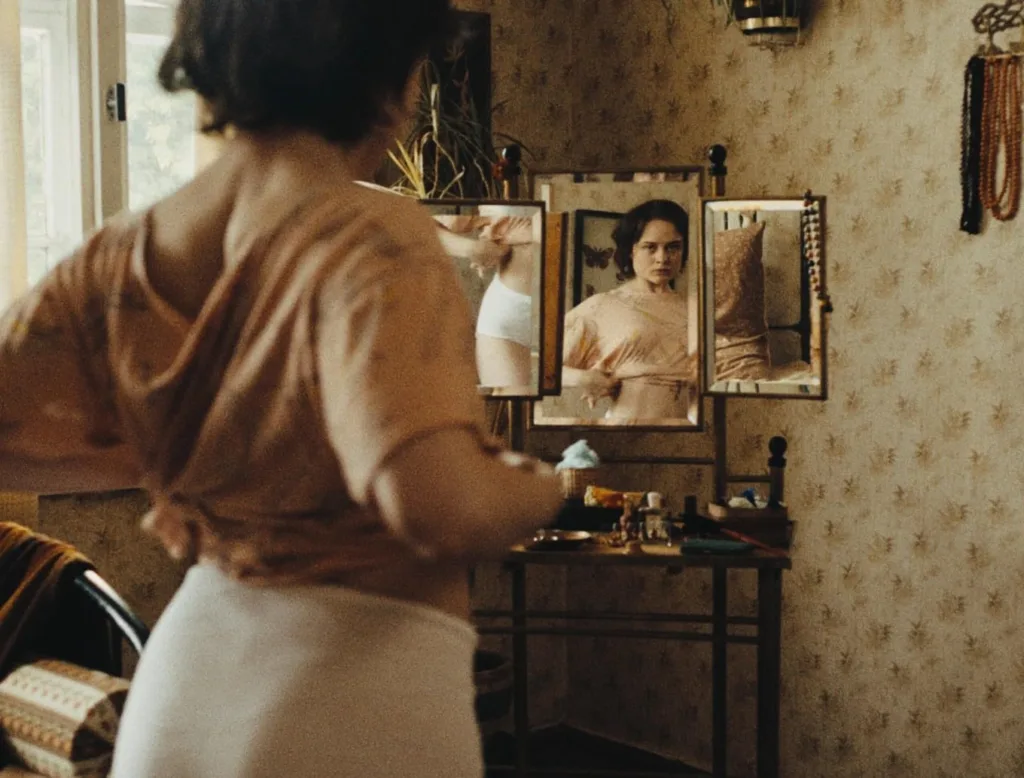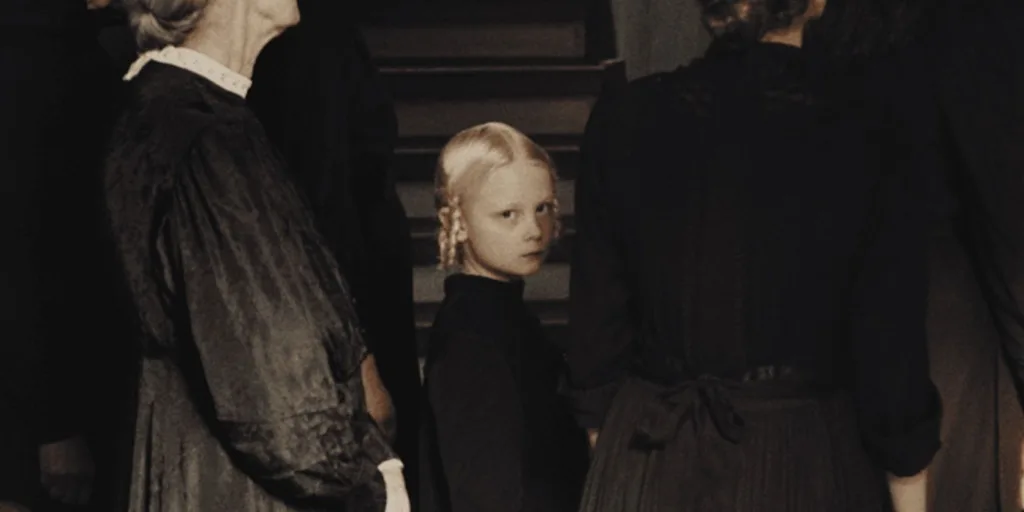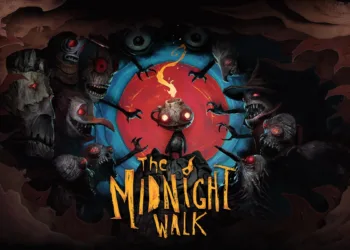Mascha Schilinski’s “Sound of Falling” arrives not so much as a film but as a temporal tremor, an ambitious disturbance in the cinematic ether. Its locus, a sprawling German farmstead in the Altmark region, is less a picturesque backdrop and more a sentient archive, quietly (or perhaps not so quietly, given the title’s sonic implications) chronicling the passage of a century within its weathered walls.
Here, the lives of four distinct generations of young women unfurl; their individual stories – separated by wars, ideologies, and the relentless march of what we generously term ‘progress’ – begin to bleed into one another, creating a kind of historical palimpsest of female experience.
The atmosphere is thick enough to bottle, an immersive distillation of profound, often deeply somber, human conditions. Prepare to be drawn into a world where time bends and the soil itself seems to remember everything.
Shattered Chronos, Anchored Earth
Forget your neat A-to-B narratives; Schilinski’s approach to storytelling here is more akin to sifting through a psychic debris field, a collection of temporal shards where memory, dream, and stark reality are presented with an almost defiant lack of linear hierarchy. The film doesn’t so much hop between epochs as it bleeds them together, tossing the viewer into the deep end of its fractured temporal pool with nary a chronological life raft. You are meant to connect the dots, or perhaps, to appreciate the pattern made by their very disconnectedness. It’s a bold gambit, demanding an active (and occasionally bewildered) participation.
At the heart of this meticulously constructed chaos are four young women, each tethered to a distinct period of German history yet all sharing the same patch of cursed, or blessed, earth. There’s young Alma, a child encountering the austere, almost medieval realities of the early twentieth century and its rather morbid fascinations – death photography, anyone? – as the Great War looms.
Decades on, Erika struggles through her teens under the shadow of another global conflict, her personal dramas playing out against the backdrop of a traumatized nation. Then, fast forward to the 1980s, where Angelika confronts her burgeoning selfhood and unsettling family dynamics within the peculiar confines of the GDR. Finally, Lenka, a contemporary transplant, moves into the renovated farmhouse, only to find that fresh paint does little to obscure the psychic strata beneath. Each girl is a world, a specific historical pressure point.
And the farm? It is the silent, brooding constant. Beyond mere geography, this Altmark farmstead acts as a vessel, a stone-and-timber repository for a century’s worth of female joy, terror, and the quiet endurance that often goes unrecorded. It’s the geographical anchor in a sea of temporal flux, its soil seemingly saturated with the unvoiced stories that the film itself is trying, in its fragmented way, to excavate.
The Perpetual Echo Chamber
These farmhouse walls, if they could speak, might offer screams or just the weary sigh of a centenarian. “Sound of Falling” posits trauma not as isolated misfortune but as a pernicious heirloom, passed down through floorboards, leaching from the soil itself. It’s a trauma-saturated geography, the psychic wounds of one era becoming phantom pains for the next. The farm doesn’t just witness history; it absorbs it into its fabric.
Across this haunted stage, the female experience unfolds in a recurring, re-costumed drama. Alma, Erika, Angelika, Lenka – each confronts the complexities of coming-of-age, their awakenings to body and desire invariably complicated by era-specific societal constraints.
From forced sterilizations (a chillingly pragmatic solution, it seems, to “make women safe for men”) to the subtler pressures of later decades, patriarchy reveals its adaptability. Yet, these are not mere chronicles of victimhood. A fierce, often subterranean, resilience flows: secret fantasies, quiet defiances, a refusal to be wholly scripted. It’s a generational déjà vu of struggle, of small, hard-won self-discoveries.
Mortality, too, is a palpable presence. The preoccupation with death – from macabre “death photographs” attempting to halt oblivion, to pervasive youthful anxieties – speaks to a fundamental wrestling with transience. Memory becomes a flickering candle. And perception? Often filtered through the narrow aperture of a keyhole or a child’s partial understanding, infusing an epistemological uncertainty. We, like them, see in part.
This personal turmoil isn’t isolated. The farm’s intimate dramas serve as an uncanny microcosm of Germany’s fractured twentieth-century: war-time austerity, ideological pressures, uneasy contemporary comforts. History is an active ingredient.
Spectral Sonics and Shadowed Canvases
“Sound of Falling” offers a tactile cinematography, a film felt as much as seen. Fabian Gamper’s camera crafts a visual grammar of decay and bruised beauty. The palette is deliberately desaturated – velvety, light-swallowing farmhouse interiors, tea-stained browns, an occasional gasp of stonewashed, melancholic blue. Light seeps rather than illuminates, catching a child’s hair like a fleeting halo or deepening shadows where old sorrows reside.
The Academy ratio isn’t nostalgic affectation; it’s a constricting frame, boxing in lives, echoing historical confines or the press of unspoken trauma. Compositions often resemble carefully preserved photographs, their grainy texture like a forgotten, damp family album. The camera, an uninvited spirit, alternates between hesitant observation from doorways and an almost uncomfortably intimate presence, its POV shots implicating us in the voyeurism. One might term it the cinematography of uneasy remembrance.
Sonically, the film is an architecture of disquiet. The title hints at an aural premonition – ‘falling’ as physical dread, historical collapse, or suffering made sound. Ominous drones swell like monstrous tides; static suggests interference from other times. The farm breathes with creaking wood, wind whispers, unseen footsteps.
Anna von Hausswolff’s contemporary vocals feel less anachronistic, more a modern medium channeling age-old laments. And the silences? Never empty. They are loaded spaces where the unsaid screams loudest. Here, the true ‘sound of falling’ might be the devastating quiet after the crash.
Flesh and Phantoms: The Farm’s Human Chorus
The young women in “Sound of Falling” operate as psychic conduits, each a vessel for the distinct anxieties and muted traumas of her epoch. Little Alma (Hanna Heckt, startlingly poised) is our initial guide, her world of stark agrarian realities and burgeoning, troubled awareness. The casual cruelty inflicted upon maids like Trudi, or the farm’s macabre photographic rituals around death, are processed through her unblinking, often uncomprehending child’s gaze, making her perspective a raw, exposed nerve.
Decades later, Erika (Lea Drinda) presents as a whirlwind of adolescent defiance, her fascination with disability and suffering a perplexing dance – perhaps a desperate bid for agency, or an attempt to control pain by confronting it head-on. Her direct, almost accusatory, stares into the camera shatter any comfortable distance, challenging our role as passive observers.
Angelika (Lena Urzendowsky), in the GDR’s waning years, threads her way through the treacherous currents of her burgeoning sexuality under the leering gaze of her Uncle Uwe (whose entitled menace feels like its own historical artifact) while also contending with the earnest, if clumsy, affections of her cousin Rainer. Hers is a tightrope walk over a familiar chasm of vulnerability and exploitation. And contemporary Lenka (Laeni Geiseler), the city transplant, finds herself an unwilling antenna, acutely sensitive to the farm’s dense emotional residue despite the fresh paint – proof that some hauntings are not so easily renovated away.
These young chrononauts of sorrow are orbited by figures who either embody the oppressive systems or bear their deepest scars. Fritz, transforming across time from youth to pain-racked amputee, symbolizes masculine fragility and the farm’s brutal exactions. Trudi is a near-silent monument to systemic abuse, her sterilized body an emblem of utilitarian cruelty. Uncle Uwe, with his unwelcome attentions, is the banal, timeless face of predatory power. They are personified pressures within the farm’s enduring, oppressive atmosphere.
Through their intertwined actions, choices, and rich inner lives – often revealed in fleeting gestures or guarded expressions – the film allows its central themes to breathe. These portraits manifest trauma’s insidious echo, the cyclical female experience opposing patriarchal headwinds, and stubborn human resilience.
A Lexicon of Lingering Ghosts
“Sound of Falling” speaks a potent symbolic shorthand, its meaning accreting through recurring visual and thematic echoes. The River Elbe, a historical marker (East/West), is also a primal force – life, death, escape, a watery Styx. Photographs, those brittle paper ghosts, attempt to arrest time: from unsettling “death photographs” (a direct form of remembrance) to fleeting Polaroids capturing something beyond the moment.
Farm structures, like the hayloft, become loaded stages for childhood’s innocent terrors and furtive adult secrets. Water in myriad forms – sweat, bath, tears, the river’s pull – saturates the film, an elemental language of life, purification, and dread.
These motifs are threads stitching disparate timelines, creating uncanny continuity. A shared gesture, a repeated phrase, light in a room – whispers across generations suggesting experience is a palimpsest. These elements operate literally yet open onto figurative depths, transforming the everyday into emblems of memory, trauma, and the cyclical turnings of this haunted world.
An Indelible Imprint: After the Fall
“Sound of Falling” is decidedly not a casual cinematic stroll; it does not offer itself up for passive consumption. It demands rigorous, almost devotional, audience engagement – a surrender to its fractured rhythms, temporal dislocations, and thematic density. Patience is a vital tool for its somber, layered world. It requires you to lean in, sift ambiguities, and bear witness to its unpalatable, human truths. It is work, certainly, but singularly absorbing and thought-provoking.
What lingers, after final images and pervasive drone fade, is profound psychic residue, an emotional and intellectual haunting. It offers no easy answers, planting persistent questions about inherited trauma, porous time, and the silent weight of unacknowledged histories, especially those of women.
It might change how you view inert landscapes, or family archives. Its sorrow has a stark, disquieting beauty, an echo reverberating with almost physical presence. This filmmaking seeps under your skin, potentially reconfiguring sensitivity to the sorrowful music of human experience across time. Its cultural mark may be measured not in applause, but in slow-burn conversations about memory and societal amnesia.
Full Credits
Director: Mascha Schilinski
Writers: Mascha Schilinski, Louise Peter
Producers: Lucas Schmidt, Lasse Scharpen, Maren Schmitt
Cast: Hanna Heckt, Lena Urzendowsky, Laeni Geiseler, Susanne Wuest, Luise Heyer, Lea Drinda, Florian Geißelmann, Greta Krämer, Claudia Geisler-Bading, Zoë Baier, Konstantin Lindhorst, Luzia Oppermann, Gode Benedix, Filip Schnack, Martin Rother, Andreas Anke, Liane Düsterhöft, Lucas Prisor, Ninel Geiger, Helena Lüer, Anastasia Cherepakha, Bärbel Schwarz
Director of Photography (Cinematographer): Fabian Gamper
Editors: Evelyn Rack
Composers: Michael Fiedler, Eike Hosenfeld
The Review
Sound of Falling
A demanding yet deeply resonant cinematic experience, "Sound of Falling" is an artistic powerhouse that masterfully interweaves generations of sorrow and resilience on a haunted German farmstead. Its fragmented narrative and dense symbolism require commitment but reward with profound insights into trauma, memory, and the indelible marks of history. A haunting, unforgettable film for the serious cinephile.
PROS
- Artistically ambitious and masterful filmmaking.
- Profound, thought-provoking exploration of trauma, memory, and the female experience.
- Haunting and immersive atmosphere created by stunning cinematography and evocative sound design.
- Rich, multi-layered symbolism that invites deep interpretation.
- An unforgettable and deeply resonant cinematic experience that lingers long after viewing.
CONS
- Highly demanding of audience patience, attention, and willingness to interpret.
- The fragmented, non-linear narrative structure can be challenging to follow.
- Its intense thematic density and consistently somber tone may not appeal to all viewers.

















































